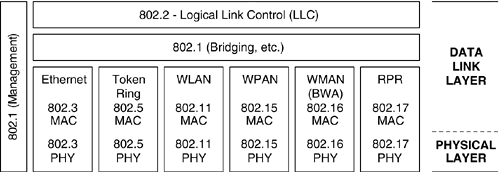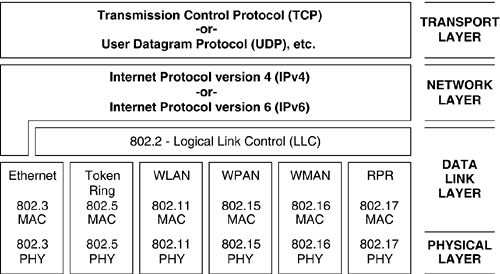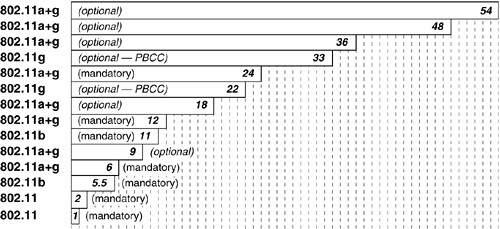Where Do Wireless LAN Standards Come From?
| The short answer is that they come from the Institute of Electrical and Electronics Engineers (IEEE), which is a nonprofit technical professional association with 380,000 members in 150 countries (as of June 2003). The IEEE oversees more than 900 active standards, with 700 under development, one of which is known as Project 802, responsible for creating standards for local area networks (LANs) and metropolitan area networks (MANs). In Project IEEE 802's own words[15] :
Therefore, IEEE Project 802 is more commonly known as the IEEE LAN/MAN Standards Committee (or [the] LMSC for short), and has been in existence since 1980. Over the decades in which the IEEE's LMSC has been in existence, it has had a large number of Working Groups (WGs), each corresponding (roughly) to a given type of LAN or MAN technology. The IEEE LMSC is divided into WGs, each of which is identified by a decimal number after the "802". For example, there is an IEEE 802.3 WG that has defined the standards for Ethernet, an IEEE 802.5 WG that defined the standards for Token-passing Rings, and the IEEE 802.1 WG defined the standards for bridging and other inter-LAN issues. The IEEE 802.1 WG is notable in that it has not standardized any particular LAN or MAN technology per se; rather it has defined the interworking rules that allow the various LAN and MAN technologies being produced by the LMSC's WGs to interoperate. As has been alluded to already, the subset of the IEEE's LMSC that has been chartered with the standardization of WLANs is called the IEEE 802.11 WG. The term IEEE 802.11 refers to the 11th WG under IEEE Project 802. The first meeting of the IEEE 802.11 WG was in 1990. Figure 1-5 illustrates numerous interactions between the IEEE 802.11 WG and other WGs, and depicts a simplified[18] version of the top-level structure of the LMSC, with the WGs inter-relationships shown in a "protocol stack" view, showing how the various WGs and their associated specifications map to the Data Link and Physical layers.[19] [20]
Figure 1-5. Top-level structure of IEEE Project IEEE 802[20]
Figure 1-6 shows the relationship of Project IEEE 802's Data Link layer standards to the IP at the Network layer. Note that in the case of Ethernet, the intermediate IEEE 802.2 (LLC) layer is not always required. Figure 1-6. Relationship of Project IEEE 802 protocols to the IP stack[20]
As can be seen in Figure 1-6, IP can be layered directly over Ethernet, or it can be layered over IEEE 802.2 LLC, which in turn operates over IEEE 802.3. However, IEEE 802.2 LLC is a required layer when IP is operating over, for example, IEEE 802.11 and IEEE 802.5. Essentially, LLC is required in all IEEE 802 technologies except for Ethernet, where it is optional. In regard to IEEE 802.11, these protocols and their exact usage will be detailed later in this book. For now, this treatment is just to establish the lay of the land. The case of IPv4 or IPv6 over Ethernet is special, in that neither of those protocols need be layered over the IEEE 802.2 LLC sub-layer in order to operate over Ethernet. Such an encapsulation is possible, but the default is for IPv4 or IPv6 to be directly encapsulated in Ethernet. The remaining IEEE 802 standards over which IP can operate, including IEEE 802.11, all require the presence of the LLC sub-layer protocol(s) between IP and the MAC sub-layer header. For the case of IEEE 802.11, these issues will be covered in great detail later in the book. Table 1-2 gives a complete list of all the entities that are (or have been) elements of IEEE Project 802. Currently active groups are in boldface type.
Note that there have been three Technical Advisory Groups (TAGs) in addition to the 16 WGs that have been defined since the beginning of Project IEEE 802. The TAGs have contributed to Project IEEE 802's work in various ways, depending on the situation that necessitated the creation of the TAG. In some cases, the TAG may be doing "technical fact finding" and producing reports that provide important information to one or more WGs. In other cases, the TAG may be a quasi-WG, or a co-WG. The main difference between TAGs and WGs is that TAGs do not produce standards. Some inactive groups may be "hibernating," which means that they can be reactivated for some purpose deemed relevant to their original charter, should a need arise. The fact that there are four WGs and one TAG active in the general area of standardizing wireless technologies indicates that wireless standardization is very important to the IEEE LAN/MAN Standards Committee (LMSC, a.k.a. IEEE Project 802), and by extension, to the companies and their customers in the data communications industry. Specifically, the following activities are underway that are relevant to wireless technology:
An overview of the IEEE 802.15 and IEEE 802.16 technologies (with minor coverage of IEEE 802.20) is presented in Chapter 8, Applications and Deployment of Wireless Technology, but a full treatment of the standards that have been, and are being, developed by these WGs is beyond the scope of this book. Interested readers can find a good introductory treatment of IEEE 802.15 and IEEE 802.16 in the fourth edition of Dr. Andrew Tanenbaum's Computer Networks, published in 2002. Within any given IEEE Project 802 WG, work is often divided among various dedicated "Task Groups" (TGs). For example, the IEEE 802.3ae TG has developed standards that will allow Ethernet to operate at 10 Gbps (that standard, until it is incorporated into a future revision of IEEE 802.3, is known as IEEE 802.3ae-2002). Within the IEEE 802.11 WG are numerous TGs that are actively standardizing various aspects of WLANs. In fact, there are so many IEEE 802.11 TGs that it may be daunting for people new to WLANs (or those who have not read this book!) to keep them straight in their minds. To whet your appetite (and hopefully not scare you away!), this book will eventually describe IEEE 802.11, IEEE 802.11a, IEEE 802.11b, IEEE 802.11c, IEEE 802.11d, IEEE 802.11e, IEEE 802.11f, IEEE 802.11g, IEEE 802.11h, IEEE 802.11i, IEEE 802.11j, IEEE 802.11k, and IEEE 802.11n. As of June 2003, the WG has produced its base standard, and five of IEEE 802.11's TGs have finished their respective task(s). Specifically, the completed TGs are IEEE 802.11a through IEEE 802.11d, and IEEE 802.11g. These TGs have all produced officially approved standards of the IEEE, and products exist that implement them. By the time you read this, it is likely that IEEE 802.11F and IEEE 802.11h will exist as approved standards, rather than as drafts. The other TGs are in varying stages of completeness, and one may possibly be approved as a standard in 2003, namely IEEE 802.11j. The remainder of the list represents the wide variety of ongoing work that is being done to further define what a wireless LAN can do, and how it can do it. Overview of IEEE 802.11's Structure and Output Thus FarThe IEEE 802.11 WG is producing the standards for WLANs at both the MAC layer and the Physical (PHY) layer. So far, it has specified one MAC and several PHYs that operate under that MAC. This is a big job, and as noted earlier it has been ongoing since 1990 (the original IEEE 802.11 WG was trying to design WLAN standards for use in the U.S. Industrial, Scientific, and Medical (ISM) band, at 915.0 ± 13 MHz). Over time, the WG's horizons were expanded as new spectrum became available (e.g., the 2.4 GHz unlicensed ISM band (2.450 ± 0.050 GHz)), and as new technology made higher performance possible (e.g., Digital Signal Processors (DSPs) that are capable of implementing advanced modulation schemes). For all but historical purposes, it is safe to ignore the IEEE 802.11 WG's early work on PHYs that were designed to operate in the 915 MHz ISM band. The first PHYs to gain widespread market acceptance operated in the 2.4 GHz ISM band. The first "real" IEEE 802.11 specification, namely IEEE 802.11-1997, defined a MAC layer and two different PHYs that allowed operation at either 1 or 2 Mbps in the 2.4 GHz unlicensed ISM band. IEEE 802.11-1997 also included a specification for a PHY based on "diffuse infrared" signals. The diffuse infrared PHY will not be discussed further, other than to note that its range is 10 meters (it could perhaps be pushed to as much as 20 meters), and it is limited to operation at either 1 or 2 Mbps, matching the speeds of the RF PHY in the base IEEE 802.11 specification. The main IEEE 802.11 specification was updated in 1999, so IEEE 802.11-1999 is the latest version. IEEE 802.11b (a.k.a. Wi-Fi™) defined "higher speed" extensions to the original IEEE 802.11-1997 specification. There were two new PHY modes that allowed operation at either 5.5 or 11 Mbps, also within the 2.4 GHz unlicensed ISM band. IEEE 802.11b products typically support all four rates: 1, 2, 5.5, and 11 Mbps. At the same time that the IEEE 802.11b TG was working on their "high rate" extensions to IEEE 802.11-1997, the IEEE 802.11a TG was working on specifying a new PHY designed to operate within the 5 GHz unlicensed national information infrastructure (U-NII) band, which partially overlaps the 5 GHz ISM band, which is at 5.800 ± 0.075 GHz. IEEE 802.11a uses a modulation technique known as Orthogonal Frequency Division Multiplexing (OFDM). When completed, IEEE 802.11a-1999 offered speeds of 6, 9, 12, 18, 24, 36, 48, and 54 Mbps. The underlined speeds, namely 6, 12, and 24 Mbps, are the data rates that every IEEE 802.11a implementation must support, but two of the three "mandatory" rates, namely 6 and 12 Mbps, are virtually identical to IEEE 802.11b's 5.5 and 11 Mbps rates. IEEE 802.11a's real appeal, initially, was the possibility of much higher top-end speeds than IEEE 802.11b. For a variety of reasons, IEEE 802.11a has failed to garner much market share (or mind-share), at least so far. There are indications that this is changing, but only time will tell how popular products based on IEEE 802.11a-1999 will become. Figure 1-7 shows the various WLAN speeds that have been standardized at the time of this writing, as well as indicating which standard is associated with each speed. Figure 1-7. IEEE 802.11 WLAN standards and speeds (Mbps)
Now that the IEEE 802.11g-2003 standard is available, products can legitimately claim to support it. Eager vendors began shipping products based on the drafts of the standard in 2002, and even without a Wi-Fi™ logo program for IEEE 802.11g-based products, they sold very well. IEEE 802.11g-2003 offers speeds up to 54 Mbps while operating at 2.4 GHz ISM band, by combining IEEE 802.11a's OFDM modulation with commodity 2.4 GHz radios to achieve speeds equivalent to those available in IEEE 802.11a. Moreover, IEEE 802.11g is backward compatible with IEEE 802.11b, and should be a natural migration path from IEEE 802.11b-based WLANs. IEEE 802.11g-2003 also provides two speeds that are not available with IEEE 802.11a, namely 22 and 33 Mbps (both of which use the optional modulation scheme known as Packet Binary Convolutional Coding, or PBCC). Full details on all of these Physical layer choices are provided in Chapter 3, Speeds and Feeds. |
EAN: 2147483647
Pages: 60


